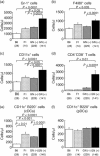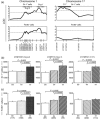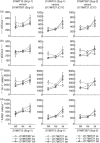Susceptibility quantitative trait loci for pathogenic leucocytosis in SCG/Kj mice, a spontaneously occurring crescentic glomerulonephritis and vasculitis model
- PMID: 24654803
- PMCID: PMC4089185
- DOI: 10.1111/cei.12333
Susceptibility quantitative trait loci for pathogenic leucocytosis in SCG/Kj mice, a spontaneously occurring crescentic glomerulonephritis and vasculitis model
Abstract
The spontaneous crescentic glomerulonephritis-forming/Kinjoh (SCG/Kj) mouse, a model of human crescentic glomerulonephritis (CrGN) and systemic vasculitis, is characterized by the production of myeloperoxidase-specific anti-neutrophil cytoplasmic autoantibody (MPO-ANCA) and marked leucocytosis. This study was performed to identify the specific populations of leucocytes associated with CrGN and susceptibility loci for pathogenic leucocytosis. Four hundred and twenty female (C57BL/6 × SCG/Kj) F2 intercross mice were subjected to serial flow cytometry examination of the peripheral blood (PB). Kidney granulocytes and monocytes were examined histopathologically. Linkage analyses were performed with 109 polymorphic microsatellite markers. Correlation studies revealed that increase of the granulocytes, F4/80(+) cells, CD3(+) CD4(-) CD8(-) T cells and dendritic cells (DCs) in peripheral blood (PB) were associated significantly with glomerulonephritis, crescent formation and vasculitis. In kidney sections, F4/80(low) cells were observed in crescent, while F4/80(high) cells were around the Bowman's capsules and in the interstitium. Numbers of F4/80(+) cells in crescents correlated significantly with F4/80(+) cell numbers in PB, but not with numbers of F4/80(+) cells in the interstitium. Genome-wide quantitative trait locus (QTL) mapping revealed three SCG/Kj-derived non-Fas QTLs for leucocytosis, two on chromosome 1 and one on chromosome 17. QTLs on chromosome 1 affected DCs, granulocytes and F4/80(+) cells, but QTL on chromosome 17 affected DCs and granulocytes. We found CrGN-associated leucocytes and susceptibility QTLs with their positional candidate genes. F4/80(+) cells in crescents are considered as recruited inflammatory macrophages. The results provide information for leucocytes to be targeted and genetic elements in CrGN and vasculitis.
Keywords: SCG/Kj mice; anti-neutrophil cytoplasmic autoantibody; crescentic glomerulonephritis; quantitative trait locus; vasculitis.
© 2014 British Society for Immunology.
Figures









Similar articles
-
Vasculitis and crescentic glomerulonephritis in a newly established congenic mouse strain derived from ANCA-associated vasculitis-prone SCG/Kj mice.Autoimmunity. 2019 Aug-Sep;52(5-6):208-219. doi: 10.1080/08916934.2019.1658191. Epub 2019 Sep 2. Autoimmunity. 2019. PMID: 31476889
-
Genetic dissection of vasculitis, myeloperoxidase-specific antineutrophil cytoplasmic autoantibody production, and related traits in spontaneous crescentic glomerulonephritis-forming/Kinjoh mice.J Immunol. 2006 Mar 15;176(6):3662-73. doi: 10.4049/jimmunol.176.6.3662. J Immunol. 2006. PMID: 16517735
-
SCG/Kinjoh mice: a model of ANCA-associated crescentic glomerulonephritis with immune deposits.Kidney Int. 2003 Jul;64(1):140-8. doi: 10.1046/j.1523-1755.2003.00061.x. Kidney Int. 2003. PMID: 12787404
-
Myeloperoxidase-antineutrophil cytoplasmic antibody-associated crescentic glomerulonephritis with rheumatoid arthritis: a comparison of patients without rheumatoid arthritis.Clin Exp Nephrol. 2010 Aug;14(4):325-32. doi: 10.1007/s10157-010-0278-z. Epub 2010 Mar 26. Clin Exp Nephrol. 2010. PMID: 20339893 Review.
-
[Anti-neutrophil cytoplasmic antibody MPO-ANCA related with disease activity of vasculitis].Nihon Rinsho Meneki Gakkai Kaishi. 2006 Apr;29(2):94-101. doi: 10.2177/jsci.29.94. Nihon Rinsho Meneki Gakkai Kaishi. 2006. PMID: 16651707 Review. Japanese.
Cited by
-
Parp1 protects against Aag-dependent alkylation-induced nephrotoxicity in a sex-dependent manner.Oncotarget. 2016 Jul 19;7(29):44950-44965. doi: 10.18632/oncotarget.10440. Oncotarget. 2016. PMID: 27391435 Free PMC article.
-
Impact of Τh1 and Τh2 cytokines in the progression of idiopathic nephrotic syndrome due to focal segmental glomerulosclerosis and minimal change disease.J Nephropathol. 2017 Jul;6(3):187-195. doi: 10.15171/jnp.2017.32. Epub 2016 Dec 25. J Nephropathol. 2017. PMID: 28975100 Free PMC article.
-
Plasma levels of M-CSF are increased in ANCA-associated vasculitides with active nephritis.Results Immunol. 2015 Oct 21;5:33-6. doi: 10.1016/j.rinim.2015.10.002. eCollection 2015. Results Immunol. 2015. PMID: 26693395 Free PMC article.
References
Publication types
MeSH terms
Substances
LinkOut - more resources
Full Text Sources
Other Literature Sources
Molecular Biology Databases
Research Materials
Miscellaneous

